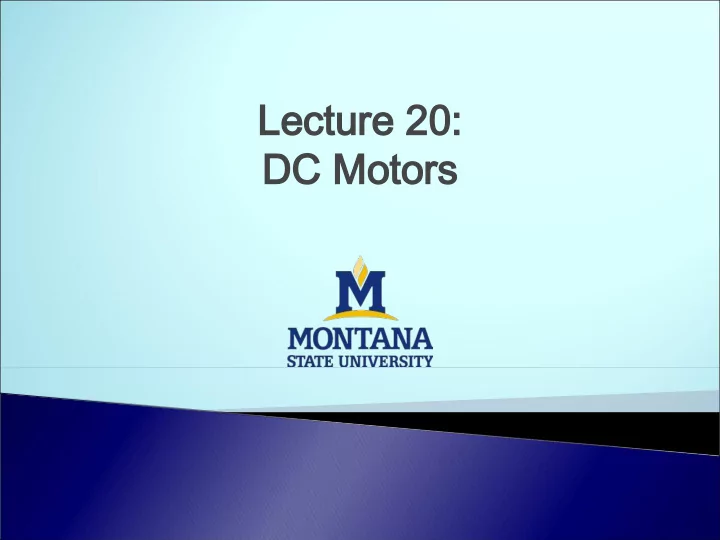

Lectur Lecture 20: e 20: DC M DC Motor otors
Exam Exam 2 Results 2 Results
Most M ost Missed Questions: issed Questions:
Most M ost Missed Questions: issed Questions:
Most M ost Missed Questions: issed Questions:
Exam Exam 2 M 2 Make- ake-up up - Fix all your mistakes on the solution problems only. - Receive up to 1/3 of the points missed on solution problems. - No partial credit will be given. Instructions: - For each problem you want to resubmit, rework each problem in it's entirety on NEW paper (even if you only missed one part of the problem). - Clearly identify each problem, subproblem, i.e. a, b, c, etc., and each answer. - Credit given by subproblem. - Must have correct and complete answers and must CLEARLY show work to receive credit. - As a minimum, make sure you write down any/all equations used in variable form prior to substituting numbers. -
DC M DC Motor otors • DC Motor electromechanical energy conversion device. – Uses DC electricity (obviously). – Converts electrical energy / power into mechanical energy / power. • Advantages: – Easy use with batteries (transportation/portable applications) – Simpler / more precise speed and torque control than AC motors • Disadvantages: – Requires “commutation” - mechanical (brushes) or power electronic based – Brushed systems require regular maintenance / replacement
Elecr Elecrom omagnetic Fundam agnetic Fundamentals entals Ampere's Law – Moving charge (current) induces a magnetic field `
Right Hand Rule ( Right Hand Rule (Conductor Conductor) • Determines direction of magnetic field • Imagine grasping conductor with right hand • Thumb in direction of current flow (not electron flow) • Fingers curl in the direction of magnetic field DO NOT USE LEFT HAND RULE IN BOOK
Right Hand Rule ( Right Hand Rule (Coil) Coil) • Imagine grasping coil with right hand • Fingers in direction of current flow (not electron flow) • Thumb points in direction of magnetic field through coil Creates electromagnet DO NOT USE LEFT HAND RULE IN BOOK
Magnetic For agnetic Force on M ce on Moving oving Char Charge ge • A magnetic field has a force on a moving charge • Lorentz Force Law Two right hand rules. Choose which one is best for you. I like the one on the right.
DC M DC Motor otor Oper Operation ation • Consider simplest DC Motor – single loop coil If No Commutation
DC M DC Motor otor Oper Operation ation • Consider simplest DC Motor – single loop coil With Commutation
DC M DC Motor otor Oper Operation ation • Real DC Motors – Rotor has multiple windings around ferromagnetic material core • Increase total force on wires (torque) • Smoother torque Rotor – Rotating electromagnetic component. In most DC machines, this is the armature. Stator – Stationary electromagnetic (or just magnetic) component. In most DC machines, these are the field magnets.
DC M DC Motor otor Oper Operation ation Electrochemically generated rotor poles repelled by like stator poles, attracted to opposite stator poles If poles align, there is no force and thus no torque To have continuous torque, commutation required
Motor otor Com Commutation utation
Motor otor Tor Torque que • Torque is the product of force and distance: • Force per conductor:
Motor otor Tor Torque que • Then, total torque exerted on rotor depends on: – Number of conductors (individual windings) – Length of conductors – Strength of main field magnetic flux density – Magnitude of the current flowing in each conductor
Motor otor Tor Torque que Example: Find the torque developed by a motor with 20 armature conductors, each 10 in. in length, and radially 3 in. from the center of the armature. The current in each conductor is 20 A, and the flux density is 60,000 lines per square inch.
Motor otor Tor Torque que Example: Find the torque developed by a motor with 20 armature conductors, each 10 in. in length, and radially 3 in. from the center of the armature. The current in each conductor is 20 A, and the flux density is 60,000 lines per square inch. Per conductor: Total armature torque: F = 8.85 B I l 2 B = 60,000 lines / in 0.2655 lb − ft x 20 8 10 I = 20 A 5.31 lb − ft F = 1.062 lb l = 10 in. R = 3 in. = F R = 0.2655 lb − ft
Counter Counter EM EMF • Motor windings “cut” through magnetic fields • Equivalent of changing magnetic field • Generates voltage in windings: Counter electromotive force (CEMF, aka Back emf) • Generated voltage in opposition to applied voltage. Effect opposes current flow.
Motor otor Speed Speed • CEMF is proportional to motor speed – EMF proportional to derivative of change in magnetic flux, which is proportional to speed. • Actual motor speed can differ from rated speed depending on load. – Rated hp and speed given for a specific load • A motor is rated at its maximum horsepower and speed at a constant load • Speed regulation: Motor speed changes by load
Wednesday Wednesday • Continue discussion of DC Motors. – Various types of motor electrical connections – Special types of DC motors • Distribution Project Assignment – Due Monday 12/2
Recommend
More recommend